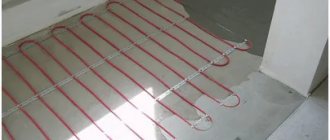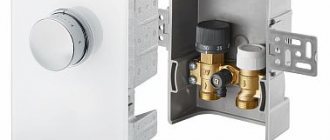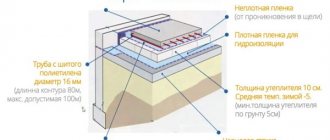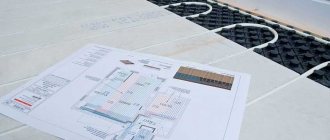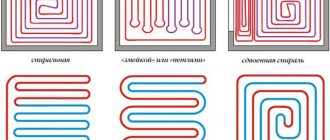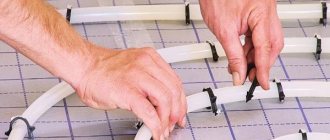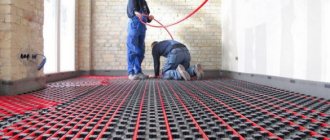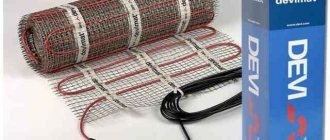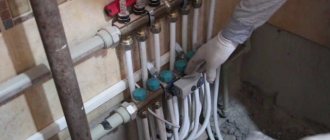Home comfort is largely determined by the microclimate that reigns in the house. However, the central heating system does not always create the desired conditions, so often the best solution is a heated floor system, which effectively copes with its task even in severe cold, providing fast and high-quality heating. The room warms up most evenly; in apartments on the first floors this is a real salvation. From this article you will learn how to properly connect a water heated floor to central heating using a plate heat exchanger.
The design of a heat exchanger as an intermediary
But first, let's take a closer look at how exactly it works. So, heat exchangers of the type under consideration are divided into non-separable (soldered) and collapsible; they are made from a wide variety of materials. Steel and brass are intended for use under high pressure conditions. Copper options are used with great success in the beer industry, they are convenient for sharp cooling of beer, there is no high pressure, but you need a good rate of thermal conductivity, which is exactly what this non-ferrous metal has. Therefore, this heat exchanger is suitable for connecting water heated floors to central heating.
In general, such heat exchangers have a wide range of applications; they are successfully used in cooling and heating systems, when working with chemicals, together with solar collectors when connected to a boiler, and also when connecting water heated floors to central heating .
Air heat exchangers
One of the most common heat exchangers today is tubular finned heat exchangers. They are also called coils. Wherever they are installed, starting from fan coils (from the English fan + coil, i.e. “fan” + “coil”) in the internal blocks of split systems and ending with giant flue gas recuperators (heat extraction from hot flue gas and transfer it for heating needs) in boiler plants at thermal power plants. That is why the calculation of a coil heat exchanger depends on the application where this heat exchanger will be used. Industrial air coolers (IACs), installed in meat blast freezing chambers, low-temperature freezers and other food refrigeration facilities, require certain design features in their design. The distance between the lamellas (fins) should be maximum to increase the time of continuous operation between defrost cycles. Evaporators for data centers (data processing centers), on the contrary, are made as compact as possible, clamping the inter-lamella distances to a minimum. Such heat exchangers operate in “clean zones”, surrounded by fine filters (up to HEPA class), so this calculation of a tubular heat exchanger is carried out with an emphasis on minimizing dimensions.
Why do you need a heat exchanger?
Let's consider a non-separable plate heat exchanger. There are four outputs on the case, that is, two circuits. The device separates flows by pressure, temperature, etc., can be used for cooling, however, we need it for heating to ensure the correct connection of heated floors. This system is connected to one circuit, and the thermal power plant to the other. Direct connection of a water heated floor to central heating may be associated with the danger of rapid failure of heated floors, since the coolant of a thermal power plant is characterized by high temperatures, high pressure, there are also special chemicals and a lot of debris . All these factors clearly will not contribute to extending the service life of heated floors.
Thus, a heat exchanger allows you to create an autonomous floor heating system with uncontaminated water and optimal pressure at home. On one side of the plate there is dirty water from the thermal power plant with high pressure, and on the other there is clean water from our autonomous system with low pressure. Such a plate provides a clear hermetically sealed separation, high-quality heat transfer, and mixing of flows is completely eliminated. The number of such thin plates determines the power characteristics of the heat exchanger.
Projects of houses with a boiler room
Number of projects 1980
- 4 rooms
- 2 bathrooms
Project AS-002
- To favorites
- 138² Total area
from 1,863,000 rub.
Construction time individually
- 1 room
- 2 bathrooms
Baths Krynnica project
- To favorites
- 55² Total area
- 9 x 6m Construction area
from 742,500 rub.
Construction time individually
- 3 rooms
- 1 bathroom
Project AS-2449
- To favorites
- 87² Total area
from 1,174,500 rub.
Construction time individually
- 10 rooms
- 4 bathrooms
House Project DOK-290 / Brussels
- To favorites
- 290.5² Total area
- 13 x 11m Construction area
from 5,229,000 rub.
Construction time individually
- 4 rooms
- 2 bathrooms
Zarechye Standard House Project
- To favorites
- 143² Total area
- 7 x 10m Building area
from 1,407,000 rub.
Construction time individually
Available at the exhibition
- 5 rooms
- 1 bathroom
Intercity House Project
- To favorites
- 145² Total area
- 10 x 7m Construction area
from 1,336,610 rub.
Construction period 75 days
- 5 rooms
- 3 bathrooms
Norbert House Project
- To favorites
- 228.2² Total area
- 11 x 16m Construction area
from 3,080,700 rub.
Construction period 125 days
- 5 rooms
- 2 bathrooms
House Project Compliment
- To favorites
- 178² Total area
- 10 x 10m Construction area
from 3,457,080 rub.
Construction time individually
- 6 rooms
- 2 bathrooms
Project AS-1516
- To favorites
- 208.8² Total area
from RUR 2,818,800
Construction time individually
- 6 rooms
- 4 bathrooms
House Project 2-363
- To favorites
- 363² Total area
from 4,900,500 rub.
Construction time individually
- 3 rooms
- 1 bathroom
House 10 Project
- To favorites
- 103.1² Total area
- 7 x 12m Construction area
from 1,245,000 rub.
Construction time individually
- 5 rooms
- 2 bathrooms
House Project No. 14104
- To favorites
- 218² Total area
- 20 x 12m Construction area
from RUR 8,675,891
Construction time individually
- 5 rooms
- 2 bathrooms
House Project MPL-0024-R0143-0232
- To favorites
- 232² Total area
- 17 x 10m Construction area
from 3,606,000 rub.
Construction time individually
- 4 rooms
- 2 bathrooms
Project Exhibition House
- To favorites
- 132² Total area
- 8 x 8m Construction area
from 1,782,000 rub.
Construction time individually
- 4 rooms
- 2 bathrooms
House Project DOK-303 / Orleans
- To favorites
- 303.4² Total area
- 14 x 15m Construction area
from 5,461,200 rub.
Construction time individually
- 5 rooms
- 2 bathrooms
Project AS-266-2
- To favorites
- 211.8² Total area
from 2,859,300 rub.
Construction time individually
- 6 rooms
- 2 bathrooms
Project AS-2081
- To favorites
- 265.36² Total area
from 3,582,360 rub.
Construction time individually
- 8 rooms
- 2 bathrooms
Oris House Project
- To favorites
- 317.9² Total area
- 16 x 17m Construction area
from RUR 4,291,650
Construction period 158 days
- 5 rooms
- 2 bathrooms
House Project 32-189
- To favorites
- 189² Total area
from 2,551,500 rub.
Construction time individually
- 4 rooms
- 2 bathrooms
House Project Edem A120
- To favorites
- 120² Total area
- 10 x 12m Construction area
from 4,500,000 rub.
Construction time individually
View all projects
In recent years, water-heated floors have increasingly been chosen as an alternative to heating radiators. Thus, the main problems of private houses are solved - cold floors and the accumulation of warm air under the ceiling. But in order for the system to function normally and cover all heat losses, a professional calculation of the heated floor is necessary at the design stage. It is quite complex and is best done by specialists. But if you wish, you can do this yourself.
Distribution of heat flows for different heating systems Source cs11.pikabu.ru
Selection of a heat exchanger for connecting a thermal power plant
In order to choose the right heat exchanger for connecting a water heated floor to central heating, you need to determine the degree of contamination of the coolant in order to understand how much the water needs to be cleaned. If the deposit is small, then a coarse filter that retains chips and scale will be sufficient. Such a filter can be cleaned with special means if after some time it becomes dirty and requires cleaning.
Each heat exchanger must contain information about the type of product, the manufacturer, the maximum and test pressure, the maximum operating temperature, the mounting location diagram, and the designation of the circuits, which can be located both diagonally and in the vertical plane. A special arrow shows the direction of installation of the product, that is, in what position it should be installed. It is important to understand how the outflow of coolants occurs. The circulation itself is carried out by the so-called circulation pump.
You can usually find on the diagram in the passport how to carry out the installation correctly. For example, one option is to press the product to the wall with a fastening tape or console and, using a special corner, screw it. Filters are required to be installed; at least a coarse filter is required.
Heat exchanger for heated floors
Comfort, hygiene, safety and efficiency are the main factors that determine the concept of home improvement for a modern person. And in order to create an optimal temperature balance in the room, people are increasingly installing water-heated floors in an apartment or private house, especially since, compared to electric counterparts, such heating systems are:
• Completely safe for residents; • Compatible with all types of floor coverings; • More reliable, energy efficient and economical; • Universal and integrated with already installed heating circuits and various automation devices.
Basics of arrangement and connection diagrams
The water heated floor in the apartment works with a carrier whose temperature does not exceed 45 ˚С. The low-temperature operating mode helps create a more favorable climate and eliminates the oversaturation of the air with positive ions, which is especially important for asthmatics, allergy sufferers and families with small children. If the configuration of the equipment and the layout of the heated floor in the apartment are carried out competently and on the basis of engineering calculations, then you can not only achieve high-quality heating, but also completely abandon the use of heating radiators, thereby expanding the usable area and significantly changing the concept of interior design.
If you are interested in how to make a heated floor in an apartment, then you will need to study the procedure for calculating hydraulic resistance and heat transfer coefficient, work out the issue of equipping the system with functional and control equipment, the process of performing thermal insulation and decorative design of floors. When arranging country houses and cottages, one should not forget about the likelihood of the system freezing; in this case, it is better to initially add ethylene glycol to the carrier.
Living in apartment buildings imposes a number of technical restrictions on the implementation of energy-saving technologies. The installed heated floor from central heating in the apartment significantly increases the overall hydraulic resistance, which immediately affects the quality of heating of neighboring rooms. And if in new houses the water heating circuit is often already structurally installed, then it is practically impossible to obtain official permission to renovate old houses.
And the solution has been found! Today, most engineering specialists and those who decide to install the system themselves use a plate heat exchanger for underfloor heating. Thanks to the installation of this small-sized device, the following is achieved:
- Increased heating efficiency;
- Compactness and increased reliability of the circuit as a whole;
- Hydraulic autonomy of the system.
Plate heat exchanger – compact and efficient
Functionally, a heat exchanger for a heated floor in an apartment is the main device that ensures the process of heat transfer from an external carrier from a common heating plant to the internal circuit. It consists of plate elements with an original stamped configuration. They are located counter-parallel to each other and two circuits are created inside the device: one that releases and one that acquires thermal energy, which independently wash each plate. External structural elements are isolated from heat-conducting parts, accordingly, energy losses are minimized and there is no need to be afraid that family members, children or pets can get thermal burns from accidentally touching the heat exchanger.
Low hydraulic resistance, small internal volume with a large contact area, good flow turbulence determine a high heat transfer coefficient and uniform heating of the liquid medium.
The reproductive energy exchange, which is provided by the heat exchanger for underfloor heating from central heating, avoids direct contact of the rust-containing and suspended coolant of the common central heating system with the cleaner refrigerant of the closed floor heating circuit. And since the plate elements are made of high-quality alloy steels, characterized by chemical inertness and high corrosion resistance, the cleanliness of the working environment is maintained over a long period and, accordingly:
The formation of lime deposits is minimized; Costs for the external coolant used are reduced; The operational life of the equipment increases.
Gasketed or soldered heat exchanger? Contact the professionals!
The variety of designs, standard sizes and commercial offers creates confusion and it becomes increasingly difficult to choose the right heat exchanger for a heated floor, to buy the most optimal model in terms of price and characteristics. Therefore, before purchasing you must:
1. Competently calculate the working pressure, volumes and speeds of the heating and heated circuits, the minimum area of the plate elements. To do this, you can resort to the services of specialists from the selling company or use specialized software.
2. Conduct a thorough comparative analysis of technical and operational parameters and installation connection conditions. Managers will provide a complete list of technical characteristics and explain the specifics of connecting various variations.
3. Consider the option of performing repair and service work. A heat exchanger for a heated floor in an apartment from central heating or an individual system in a country cottage, like any technological equipment, requires preventive maintenance. Collapsible models will require cleaning at service centers and possibly replacement of seals; soldered ones can be washed independently or through the services of professionals.
4. Decide on the design. Collapsible models have a distinct technical design; as standard, they are designed for a maximum operating pressure of up to 25 bar and require periodic inspection. Soldered models are more compact, have streamlined shapes and a laconic design, and can withstand water hammer up to 35 bar.
When installing a heated floor from heating in an apartment, it is important to ensure its functionality and hydrosafety, to maximally preserve the usable area and maintain the high aesthetics of the interior. Therefore, it is more advisable to install a soldered plate heat exchanger for a heated floor in an apartment; the price of these modifications is also slightly lower than that of collapsible structures.
Contacting a specialized company guarantees a variety of assortments, provision of competent advice and compliance of products with State Standards and declared parameters.
Pressure and other characteristics of aluminum batteries
If for some reason the boiler is turned off, be sure to drain the hot water from the radiator, otherwise the pipes may burst.
In multi-storey buildings with central heating and in individual heating systems of cottages and apartments, aluminum batteries are often used. They are designed for a pressure of 16-18 atmospheres. Aluminum radiators have a modern design, excellent thermal and strength parameters and are currently the most common.
They are made from die-cast aluminum. This manufacturing technology allows us to ensure high strength of finished products. Aluminum radiators are structures made of separate sections from which batteries of the required length are assembled. They come in sizes of 80 and 100 mm deep with a standard section width of 80 mm.
Aluminum has a thermal conductivity 3 times greater than that of steel or cast iron, so such batteries have a very high heat transfer rate. The high thermal power of radiators of this type is also achieved due to additional fins, which provide a large contact area between the air and the heated surface.
Aluminum radiators are designed for pressure from 6 to 20 atmospheres. Reinforced models of aluminum batteries are also produced, designed for the CIS countries - for apartment buildings with a central heating system with more severe operating conditions. Such batteries are made of durable high quality aluminum and have thicker walls.
Aluminum heating radiators are small-sized and lightweight, while they are characterized by high heat transfer. They have an attractive appearance. It is generally accepted that such batteries are optimal in conditions of autonomous heating (cottages, private houses, dachas, estates). However, the working pressure of aluminum radiators of 16 atmospheres allows them to be installed in apartments of multi-storey buildings.
General information on the calculation results
- Total heat flow
- Heat flow in the upward direction
- Heat flow downward
- Total specific heat flux
- Total heat flow per linear meter
- Average coolant temperature
- Maximum floor temperature
- Minimum floor temperature
- Average floor temperature
- Pipe length
- Thermal load on the pipe
- Coolant flow
- Coolant movement speed
- Linear pressure loss
- Total coolant volume
— Amount of heat released into the room. If the heat flow is less than the heat loss of the room, additional heat sources are needed, for example, wall radiators.
— The amount of heat released into the room from 1 square meter of area in the upward direction.
— The amount of “lost” heat that does not participate in heating the room. To reduce this parameter, it is necessary to select the most effective thermal insulation under the TP* (*warm floor) pipes.
— The total amount of heat generated by the TP system from 1 square meter.
— The total amount of heat generated by the TP system from 1 linear meter of pipe.
— The average value between the calculated temperature of the coolant of the supply pipeline and the calculated temperature of the coolant of the return pipeline.
— Maximum floor surface temperature along the axis of the heating element.
— Minimum floor surface temperature along the axis between the TP pipes.
— Too high a value of this parameter can be uncomfortable for a person (standardized by SP 60.13330.2012). To reduce this parameter, it is necessary to increase the pipe pitch, reduce the temperature of the coolant, or increase the thickness of the layers above the pipes.
— The total length of the TP pipe, taking into account the length of the supply line. With a high value of this parameter, the calculator will calculate the optimal number of loops and their length.
— The total amount of thermal energy received from thermal energy sources is equal to the sum of the heat consumption of thermal energy receivers and losses in heating networks per unit time.
— Mass amount of coolant intended to supply the required amount of heat to the room per unit of time.
— The higher the speed of movement of the coolant, the higher the hydraulic resistance of the pipeline, as well as the level of noise created by the coolant. Recommended value is from 0.15 to 1m/s. This parameter can be reduced by increasing the internal diameter of the pipe.
— Decrease in pressure along the length of the pipeline caused by the viscosity of the liquid and the roughness of the internal walls of the pipe. Without taking into account local pressure losses. The value should not exceed 20000Pa. Can be reduced by increasing the internal diameter of the pipe.
— The total amount of liquid to fill the internal volume of the pipes of the TP system.
The calculator is working in test mode. Calculator added date 03/11/2018

